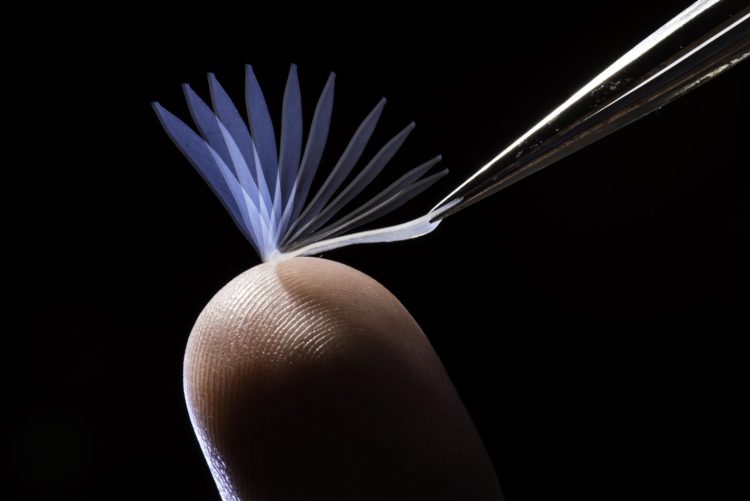Body temperature triggers newly developed polymer to change shape

A time-lapse photo of a new shape-memory polymer reverting to its original shape after being exposed to body temperature. Photo by Adam Fenster/University of Rochester
Polymers that visibly change shape when exposed to temperature changes are nothing new. But a research team led by Chemical Engineering Professor Mitch Anthamatten at the University of Rochester created a material that undergoes a shape change that can be triggered by body heat alone, opening the door for new medical and other applications.
The material developed by Anthamatten and graduate student Yuan Meng is a type of shape-memory polymer, which can be programmed to retain a temporary shape until it is triggered–typically by heat–to return to its original shape.
“Tuning the trigger temperature is only one part of the story,” said Anthamatten. “We also engineered these materials to store large amount of elastic energy, enabling them to perform more mechanical work during their shape recovery”
The findings are being published this week in the Journal of Polymer Science Part B: Polymer Physics.
The key to developing the new polymer was figuring out how to control crystallization that occurs when the material is cooled or stretched. As the material is deformed, polymer chains are locally stretched, and small segments of the polymer align in the same direction in small areas–or domains–called crystallites, which fix the material into a temporarily deformed shape. As the number of crystallites grows, the polymer shape becomes more and more stable, making it increasingly difficult for the material to revert back to its initial–or “permanent”–shape.
The ability to tune the trigger temperature was achieved by including molecular linkers to connect the individual polymer strands. Anthamatten's group discovered that linkers inhibit–but don't stop–crystallization when the material is stretched. By altering the number and types of linkers used, as well as how they're distributed throughout the polymer network, the Rochester researchers were able to adjust the material's stability and precisely set the melting point at which the shape change is triggered.
Heating the new polymer to temperatures near 35 ?C, just below the body temperature, causes the crystallites to break apart and the material to revert to its permanent shape.
“Our shape-memory polymer is like a rubber band that can lock itself into a new shape when stretched,” said Anthamatten. “But a simple touch causes it to recoil back to its original shape.”
Having a polymer with a precisely tunable trigger temperature was only one objective. Of equal importance, Anthamatten and his team wanted the material to be able to deliver a great deal of mechanical work as the shape transforms back to its permanent shape. Consequently, they set out to optimize their polymer networks to store as much elastic energy as possible.
“Nearly all applications of shape memory polymers will require that the material pushes or pulls on its surroundings,” said Anthamatten. “However, researchers seldom measure the amount of mechanical work that shape-memory polymers are actually performing.”
Anthamatten's shape-memory polymer is capable of lifting an object one-thousand times its weight. For example, a polymer the size of a shoelace–which weighs about a gram–could lift a liter of soda.
Anthamatten says the shape-memory polymer could have a variety of applications, including sutures, artificial skin, body-heat assisted medical dispensers, and self-fitting apparel.
Media Contact
All latest news from the category: Materials Sciences
Materials management deals with the research, development, manufacturing and processing of raw and industrial materials. Key aspects here are biological and medical issues, which play an increasingly important role in this field.
innovations-report offers in-depth articles related to the development and application of materials and the structure and properties of new materials.
Newest articles

Machine learning algorithm reveals long-theorized glass phase in crystal
Scientists have found evidence of an elusive, glassy phase of matter that emerges when a crystal’s perfect internal pattern is disrupted. X-ray technology and machine learning converge to shed light…

Mapping plant functional diversity from space
HKU ecologists revolutionize ecosystem monitoring with novel field-satellite integration. An international team of researchers, led by Professor Jin WU from the School of Biological Sciences at The University of Hong…

Inverters with constant full load capability
…enable an increase in the performance of electric drives. Overheating components significantly limit the performance of drivetrains in electric vehicles. Inverters in particular are subject to a high thermal load,…





















